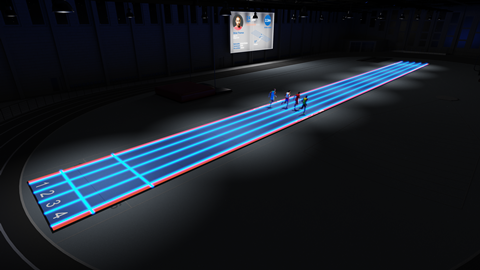Alvina Chen, CEO of Feldspar, on how AI and new technologies could improve the viewer experience of athletics

Currently, in the world of athletics, access to real-time data for athletes, broadcasters and spectators, lags behind other sports like football and premium motorsports. At world-class athletics events, cameras traditionally used mainly for broadcasting are also deployed to gather stats and metrics such as sprint times, race positioning, and running speeds. However, this information isn’t accessible immediately or even right after after a race. As a result, broadcasters, spectators, and commentators miss out on the excitement and insights that live data would have offered and limit the knowledge on “why” and “how” a race was won. In contrast, football broadcasts offer instant stats throughout the match, enriching the viewing experience with detailed and immediate insights as the story unfolds on the pitch.
Broadcasters play a crucial role in elevating the profile of any sport and bringing excitement to millions of people around the world. In athletics, for example, spectators tuning into the live broadcast generally have access to high quality analysis provided by former athletes. However, there’s still a fantastic opportunity for broadcasters to do more, if the appropriate technology existed. For example, they could incorporate real-time data and engaging insights immediately after the race leveraging relevant technological innovations. This could add more layers of nuanced data that would provide additional evidence to complement high-level analysis, and ultimately, bring a richer and more exciting story to viewers.
Fans are incredibly passionate about supporting their favourite athletes or countries during global events, as evidenced by the recent stories suggesting that this summer’s games drew huge broadcast viewership figures. Generally, fans’ understanding of athletics is often limited to race times and medal winners. However, expanding the availability of data and analytics in athletics could deepen fans’ appreciation for the precision and technique required in events like the 100m sprint. For example, providing data on how Noah Lyles managed to move from outside the medal positions to winning gold in the last ten metres of the 100 metre final would add additional colour allowing fans to have further appreciation of his incredible performance.
By utilising AI and technology to supply data in real-time, a deep level of analysis and insights could be presented in visually engaging formats such as charts, graphs and graphics, enhancing the viewers’ understanding and drawing them closer to the action on the track. The advancement of data also opens the conversation about how broadcasters can commercialise and monetise data in athletics. This could come via partnerships or sponsorship, thus increasing the commercial value of live athletics coverage.
Athletics is entering an exciting period of growth both on and off the track. As the world and sports industry continues to embrace the benefits of AI, it’s clear that athletics is set to benefit from a digital revolution. With heavily data-driven sports already winning over fans elsewhere, there is no doubt that broadcasters will also look for novel ways to help athletics spectators get closer to the action than ever before.

Alvina Chen is CEO of Feldspar








No comments yet